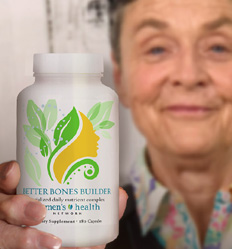The research is clear: exercise is one of the best ways to maintain and increase bone density and bone strength. But with so many different forms of exercise to choose from — from high-intensity workouts to yoga to walking around the block — how do you choose the best weight-bearing exercises for your bones?

Whatever your fitness level, there’s a form of exercise that will help you reach your goals. Let’s explore different bone-building exercise modalities to help you find your best fit.
Weight-bearing exercises for bone health
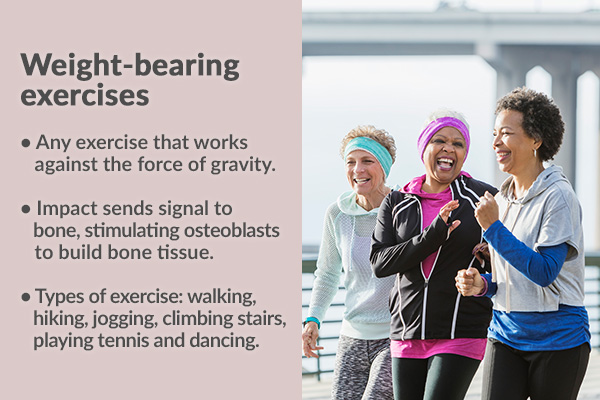
Bone responds to the forces applied to it. This includes the force generated by muscles and tendons tugging on bone when you move, as well as the force of gravity. When you walk, run, hop and skip, you are pushing against gravity in order to move. The impact of your every step sends a signal to bone to grow stronger to help keep you moving.
Besides walking, simple weight-bearing exercises include hiking, jogging, climbing stairs, gardening, playing tennis and dancing. Check with your health care provider about the safety of any new exercise regime.
Women who haven’t exercised much recently can start with these lower-impact exercise ideas:
- Walking after dinner or before work in the morning
- Running up and down the stairs
- Hopping on both legs
- Dancing
- Hiking on your favorite nature trail
For more bone-building impact, simply stand in place and jump and land firmly on both feet. You may even decide to wear a weighted vest during your weight-bearing workout. More weight pushing down (that your skeleton must resist) sends even stronger signals to bone to start building.
Strength-training exercise for bone health
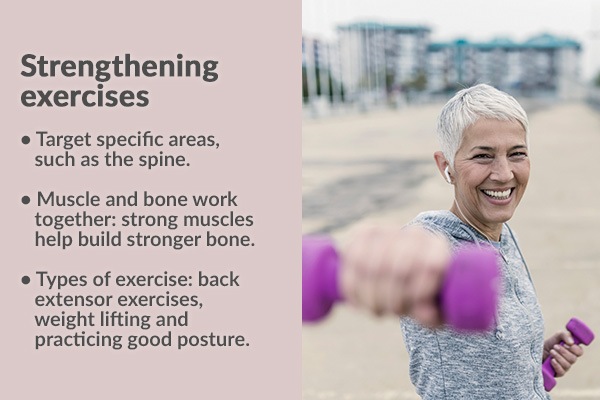
Strength training uses higher intensity weight-bearing exercise to target certain parts of the skeleton. Strength training typically involves the use of hand weights or dumbbells to create added resistance for your muscles and bones, or squats and other strengthening exercises that use your own body weight to create resistance.
Bone and muscle work as a single unit, so any time you use a muscle, you’re stimulating your bones. The effects of strength-training exercises on bone are site-specific, which means you can work particular muscles to strengthen particular bones — very useful if you’ve had a fracture, or if you’ve been told you have bone loss in your hip, spine or wrist.
Studies on strength training and its ability to increase bone density have yielded impressive results. One very successful German study found that postmenopausal women gained an average of 11% bone mineral density in the hip after three years of strength training.
In another study, called the LIFTMOR study, postmenopausal women trained with heavy weights for just 30 minutes, twice a week, and saw on average a 3% increase in lumbar spine BMD, and 13.6% increase in cortical thickness in the hip in just 8 months, compared to a control group. The 30-minute sessions involved high-intensity resistance exercises including deadlifts, overhead presses, back squats and jumping chin-ups with drop landings. This is definitely a “don’t try this at home” kind of workout for the inexperienced. If you are interested in high intensity weight lifting, work with an experienced trainer in this area.
One strength-training exercise almost anyone can do right now is to consciously improve your posture. The very act of standing and sitting up straight is actually a form of strength-training for your back and spine.
Pilates exercise for bone health
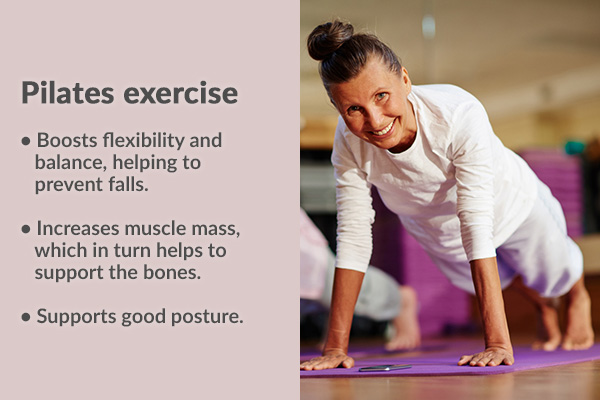
Pilates is a set of exercises first developed by Joseph H. Pilates during World War I as he worked with recovering soldiers. Pilates exercise routines focus on strengthening the core muscles of the body that support the spine and also incorporate breath awareness.
I like Pilates as an exercise because it has such a focus on alignment. We tend to look down a lot due to computer usage, leading to poor posture and weakness in the small muscles around the spine. Pilates helps strengthen these spinal muscles and the bone attached to them and helps us build stronger balance. Pilates also encourages deep, natural breathing, which helps reduce stress.
If you want to try Pilates, look for classes that are specifically for women with bone health issues, or talk to the instructor of the class to understand how you can modify positions to protect your bones. Exercises that work the back, shoulders, legs and hips are the most beneficial for people with osteoporosis.
Yoga exercise for bone health

Yoga is wonderful for bone health on many levels. For one, it helps improve balance and coordination, both of which are important to prevent falls. As you practice yoga, you learn to hold poses for long periods of time and shift your body weight to one side or the other. Both of these practices offer an extra load that creates more tension from tendons pulling on bone. The more tension, the more new bone your body will make.
Dr. Loren Fishman has proven in his pilot studies that just 10 minutes of yoga a day can improve bone density. Another study showed that women who did yoga for one hour, 4 days a week, for just 6 months gained bone density.
Beneficial yoga poses for bone include Vrksasana (Tree Pose), Utthita Trikonasana (extended triangle pose) and Virabhadrasana II (warrior pose II).
Tai chi for bone health

Tai chi is an ancient exercise that helps strengthen bone while relaxing the mind. It increases balance and flexibility and has been shown in multiple studies to slow bone loss.
Research shows that long-term practitioners have better bone mineral density as they age than those who don’t practice Tai chi. Not to mention, one study found that Tai chi can significantly reduce the rate of falls in older adults.
Start exercising now — 7 simple weight-bearing exercises for bone health
Even gentle, low-impact, weight-bearing exercises can help build muscle and bone. The following exercises focus on simple strength training using the natural resistance of your own weight. Consult your physician before starting any new exercise program, and work with a physical therapist if there is concern about your risk of fracture.
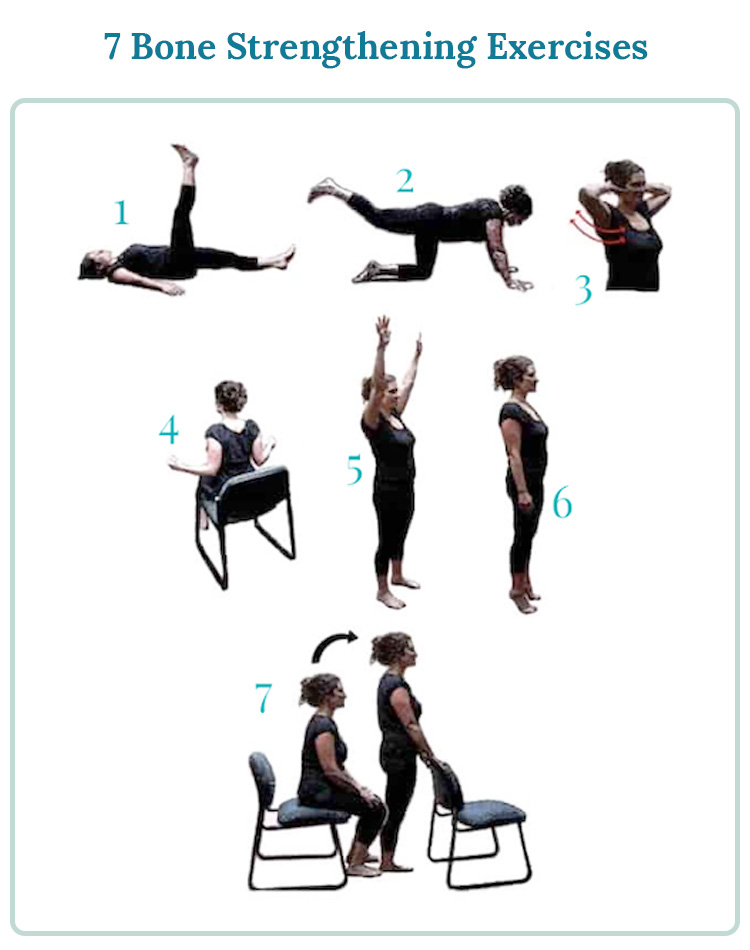
Exercise 1: Leg lift
Leg lifts target the bones and muscles of the legs, back and spine. Lay down on a mat or towel with your legs and back flat against the floor. Keep your arms on your sides. Now keep your legs straight and raise your left leg with feet up until pointing straight in the air. Hold for a count of 8 before slowly lowering the leg to the floor. Repeat with the other leg. Aim for 12 raises on each side.
The key mistake to avoid in this exercise is arching your lower back, which lets your ab muscles slack off and puts more pressure on your hip flexors and back extensor muscles. Consciously press your lower back towards the floor to maintain the proper position.
Exercise 2: Leg lifts on hands and knees
Begin on your hands and knees (quadruped position), with your hands directly underneath the shoulders and knees directly underneath the hips. Keep your abdominals pulled in tight (to help protect your lower back) and your spine in a neutral position. Lift your leg only as high as is comfortable. This exercise benefits your hips and spine.
Exercise 3: Double arm squeeze
This double arm squeeze exercise strengthens the spine. To perform, stand upright or sit in a chair with good posture. Bring your arms up and rest your hands behind your head. Your elbows should be perpendicular to your spine. Squeeze in, bringing your elbows together in front of your face. Slowly return to a position perpendicular to the spine. Repeat 12 times. Do not twist at waist or turn or bend the spine.
Exercise 4: Shoulder blade squeeze
This is another spine-strengthening exercise that can be done seated in a chair. To perform, sit upright and squeeze your shoulder blades together for a count of eight. Do this holding weights if you can for added resistance. Repeat 12 times.
Exercise 5: Arms over head
Lift arms straight from your sides up above your head, with weights if you can. Hold for a count of 8 before lowering your arms back to your sides. Repeat 12 times. This exercise strengthens your spine and arms.
Exercise 6: Tippy toes
Raise yourself up on your toes, hold for as long as you can, then slowly lower yourself down again. Repeat 12 times. This is a great all over strengthener. When you lower yourself, it’s okay to really let yourself “drop” or “plop” back down, keeping knees soft. This impact sends a signal to bone to build and strengthen. Stand on a thin yoga mat or towel for comfort, if desired.
Exercise 7: Chair stands
This is a helpful exercise for the spine, hips and legs. Start in a seated position with a chair in front of you for balance, raise yourself to your feet while maintaining upright posture. Lift your body using the muscles in your legs, buttocks and lower back — not the muscles in your arms or upper back. Tip: extend your arms to the front chair for balance, but do not press upon the chair back.
Exercise “don’ts” for those with osteoporosis or osteopenia
Some weight-bearing exercises aren’t recommended for those who have fractured or who have severe osteoporosis. Exercises to avoid include:
- Flexion exercises where you bend your spine significantly forward. These exercises can increase the risk of vertebral fractures by putting excessive pressure on the vertebral bodies. Such exercises may include crunches where you round your back, touching your toes from a standing position, pulling your knees into your chest and lifting your chin and neck while on your back, or rounding your back over and downward while in a seated position.
- Exercises that curve or bend the spine increase your chances of vertebral fracture.
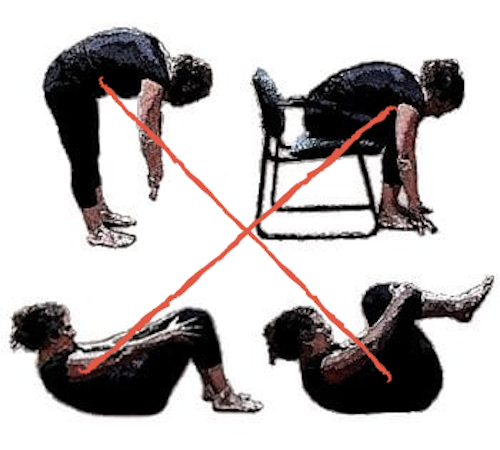
It’s common for people diagnosed with osteoporosis or osteopenia to be a little afraid of weight-bearing exercises and other types of exercise, because they are worried their bones might fracture with any unusual activity. Such caution is warranted in some situations, such as if your bone density is very low compared to other women your age, or if your body is in a very deconditioned state. But in the vast majority, this is not the case. Almost everyone can start with a program of walking, and most can safely undertake a significant bone-building exercise program with great success. But it’s important to work with your healthcare practitioner and take care not to put excessive stress on weakened bones.
Your complete bone health program

Exercise is one of those “bone treatment” plans that really doesn’t have negative side effects when the right exercises are chosen. For the most part, only positive things can come from starting an appropriate exercise program. Try my Exercising for Bone Health DVD for more safe workout ideas.
Exercise isn’t the only way to create stronger bones, however. There are key nutrients that aid us in building bone and I recommend trying our exclusive Better Bones Builder supplement to be sure you get optimal amounts of all of these nutrients every day.
Eating an alkaline diet, engaging in practices that promote regular detoxification and managing your stress also boost your bone health. Our Better Bones Program can help you with all of these elements — and we make it simple and easy to understand.
References
Nelson, M. 2000. Strong Women, Strong Bones: Everything You Need to Know to Prevent, Treat, and Beat Osteoporosis, 221. NY: Berkley Publishing Group.
Zhang, P., et al. 2008. Joint loading modality: Its application to bone formation and fracture healing. Br. J. SportsMed.,42(7),556–560.URL(abstract):https://bjsm.bmj.com/content/42/7/556.abstract (accessed 01.13.2010).
Brown, S. 2000. Better Bones, Better Body, 305. Los Angeles: Keats Publishing.
Guadalupe–Grau, A., et al. 2009. Exercise and bone mass in adults. Sports Med., 39 (6), 439–468.
Barry, D., & Kohrt, W. 2009. Weight-bearing exercises and the preservation of bone health. J. Cardiopulm. Rehab. Prev., 28 (3), 153–162. URL (abstract): https://www.ncbi.nlm.nih.gov/pubmed/18496313 (accessed 01.13.2010)
Huang, T., et al. 2003. Effects of different weight-bearing exercises on mineralization, structure, and biomechanical properties of growing bone. J. Appl. Physiol., 95 (1), 300–307. URL: https://jap.physiology.org/cgi/content/full/95/1 /300 (accessed 01.13.2010)
Manske, S., et al. 2009. Bone health: Part 2, physical activity. Sports Health, 1 (4), 341–346. URL: https://sph.sagepub.com/content/1/4/341.abstract (accessed01.11.2010).
Taaffe, D., et al. 1995. Differential effects of swimming versus weight-bearing exercises on bone mineral status of eumenorrheic athletes. J. Bone Miner. Res., 10 (4), 586-593. URL: https://jap.physiology.org/cgi/external_ref?access_num=A1995QQ47900010&link_type=ISI (accessed 01.13.2010).
Guadalupe–Grau, A., et al. 2009. 10 Taaffe, D., et al. 1995.
Myers, E., et al. 1993. Geometric variables from DXA of the radius predict forearm fracture load in vitro. Calcif. Tissue Int., 52 (30), 199–204. (accessed 01.13.2010).
Fishman, L. 2009. Yoga for osteoporosis: A pilot study. Topics in Ger. Rehab., 25 (3), 244–250. URL (abstract): https://journals.lww.com/topicsingeriatricrehabilitation/Abstract/2009/07000/Yoga_for_Ost eoporosis__A_Pil ot_Study.9.aspx (accessed 01.11.2010).
Phoosuwan, M., et al. 2009. The effects of weight-bearing yoga training on the bone resorption markers of postmenopausal women. J. Med. Assoc. Thai., 92 (Supple. 5), S102–S108. URL (abstract) https://www.ncbi.nlm.nih.gov/pubmed/19891384 (accessed 01.14.2010).
Engelke, K., et al. 2006. Exercise maintains bone density at spine and hip EFOPS: A 3-year longitudinal study in early postmenopausal women. Osteoporos. Int., 17 (1), 133–142. URL: https://www.ncbi.nlm.nih.gov/pubmed/16096715 (accessed 07.22.2008).
Pruitt, L. et al. 1992. Weight-training effects on bone mineral density in early postmenopausal women. J. Bone Miner. Res, 7 (2), 179–185.
Kemmler, W., et al. 2004. The effect of habitual physical activity, non-athletic exercise, muscle strength, and VO2max on bone mineral density is rather low in early postmenopausal osteopenic women. URL (PDF): https://www.ismni.org/jmni/pdf/17/13KEMMLER.pdf (accessed01.14.2010).
Bonnet, N., & Ferrari, S. 2010. Exercise and the skeleton: How it works and what it really does. IBSM BoneKEy,
Barry, D. W., and W. M. Kohrt. 2008. Exercise and the preservation of bone health. Journal of Cardiopulmonary Rehabilitation and Prevention 28:153–162.







